miuge
Veteran Member
  
Joined: March 2014
Posts: 200 
|
Post by miuge on Mar 24, 2014 8:38:52 GMT -5
How did you bend the frame pipes? Just noticed few wrinkles.. Though I think it doesn't matter in this case. I used Biltema's hydraulic pipe bender when making a roll cage in my car project, it did wrinkles even with sand in the pipe, solution was to fill pipes with water and freeze them..  i187.photobucket.com/albums/x281/mice325/IMG_2615_zpse30cd6e5.jpg i187.photobucket.com/albums/x281/mice325/IMG_2615_zpse30cd6e5.jpg |
|
|
|
Post by Johansson on Mar 24, 2014 9:39:44 GMT -5
I used a simple hydraulic pipe bender most likely similar to the Biltema model, the wringles look bad but I don´t think they matter. Might add a piece of CrMo plate over them though for extra strenght and better looks. .)
|
|
|
|
Post by Johansson on Mar 24, 2014 23:58:01 GMT -5
Now what is this? 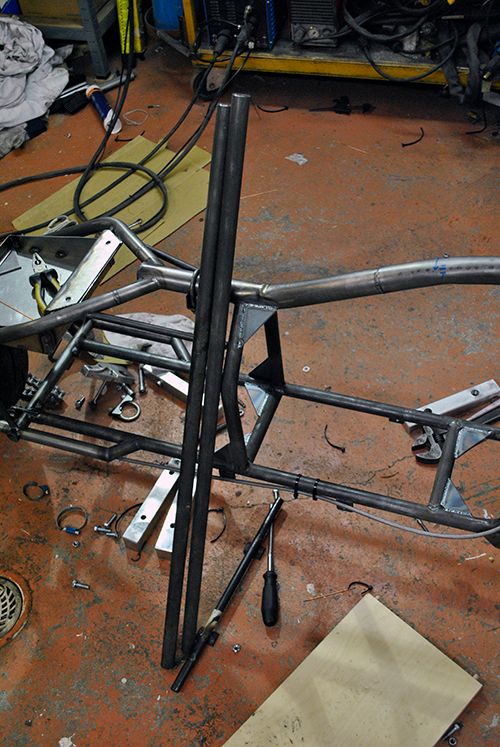 A couple of gentlemen at Landracing.com has told me that a single upper frame tube is like begging for handling problems at higher speeds, so I´ve decided to try to cure that now when the frame is unwelded and in the workshop.  A 1 1/2" CrMo tube on each side of the original frame tube with a number of shorter tubes tying them together will do the trick. 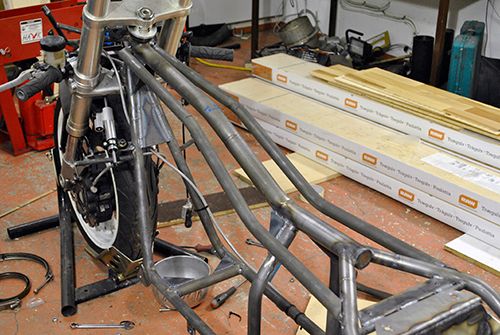 I am pretty pleased with last night, my original thought was to hit the sofa and see the lastest episode of The Walking Dead but decided to get busy and changed floor in almost an entire bedroom and made the frame tube modification to the bike instead.  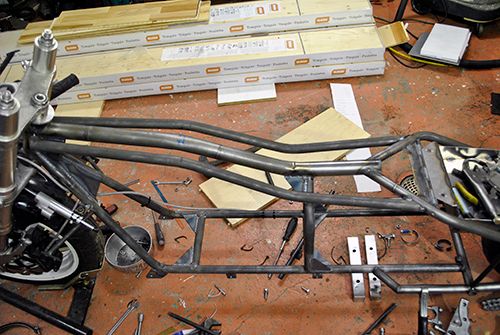 Cheers! /Anders |
|
|
|
Post by Johansson on Mar 27, 2014 0:11:53 GMT -5
Last night I made the last handful of frame tubes and started welding the frame up. 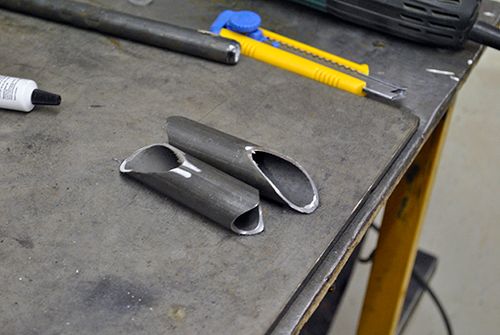 I added three connecting tubes on each side of the central upper frame tube and one between the newly added upper frame tubes and the vertical frame tube that connects the upper and lower frame tubes. Dang hard to describe and I forgot to take any closeup pic of it but it can be seen in the fourth pic below if you look closely. 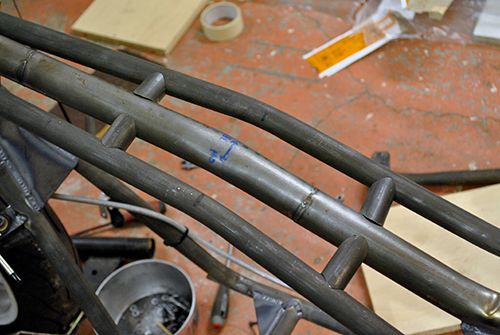 After that I removed the wheels and forks and lifted the bare frame up on a pair of stands to make welding easier, I haven´t weighed it yet but it feels like can´t weigh many kgs. 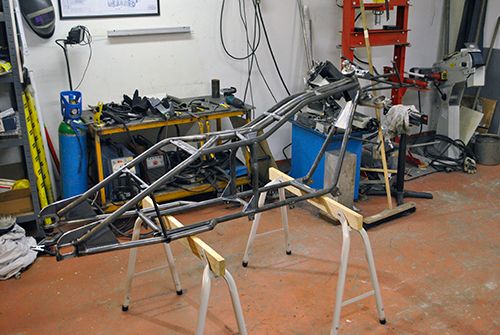 Some are probably wondering why I don´t use the frame jig while welding the frame. I chose not to because 80% of the frame already is welded so it should stay in shape pretty well, and I will still have to align the wheel axles by modifying the chain tension blocks for the rear wheel when I am done so it doesen´t matter if there is some minor movement in the frame now. Therefore I find it better that the frame can move freely than to build in tension in it. 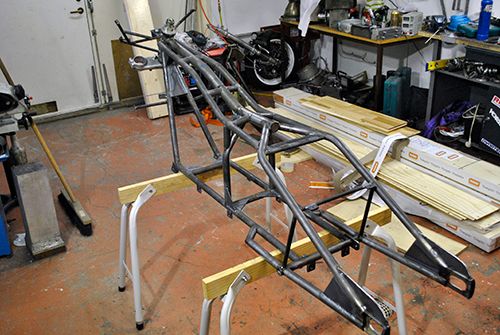 I hope tech inspection find the welds acceptable, I will take a bunch of pics before I paint the frame just to be on the safe side.  Cheers! /Anders |
|
metiz
Senior Member
  
Joined: April 2011
Posts: 297
|
Post by metiz on Mar 27, 2014 15:11:07 GMT -5
That's one sexy frame. What kind of tech inspection?
|
|
|
|
Post by Johansson on Mar 27, 2014 16:14:22 GMT -5
At Bonneville, I am not sure if they are overly cranky as long as it looks like the welder knew what he was doing but I am not taking any chances. Wouldn´t want to get turned down at tech inspection due to some unknown rule against undocumented welds covered by paint. More welding tonight by the way. 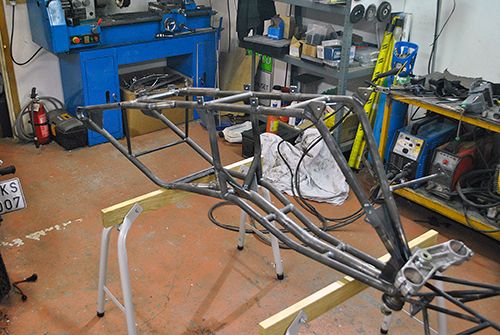 Cheers! /Anders |
|
gidge348
Senior Member
  
Joined: September 2010
Posts: 426 
|
Post by gidge348 on Mar 27, 2014 19:43:29 GMT -5
Not sure about Bonneville, but at Lake Gairdner, the main thing they don't like is ground back, puttied over, heavy powder coated or "cleaned up" welds.
Just painted should be fine.
Greg (ozbooster/maj) is a tech inspector so may be able to shed more light.
I think they all look fine.
Cheers Ian...
|
|
|
|
Post by Johansson on Mar 28, 2014 14:33:15 GMT -5
Hi Ian,
I have heard similar stories about the US events, there aren´t any serious inspection of the frame stability but more of a general check if it looks like it will stay in one piece during the run.
Cheers!
/Anders
|
|
gidge348
Senior Member
  
Joined: September 2010
Posts: 426 
|
Post by gidge348 on Mar 28, 2014 20:19:15 GMT -5
You are right Anders,
I guess by definition all the vehicles we race on the salt are "experimental" even modern road cars and bikes that have had millions in R&D spent on them are doing something they were not designed for.
At lake Gairdner (and Bonneville I presume), they work on licencing runs.
Firstly they are tech inspected, safety gear correct, no obvious bits that will fall off, sharp pieces covered, "nice welds" etc. They don't do torsional rigity tests or magnaflux or the like. Magnesium wheels need a certificate but steel are usually fine, spoke wheels have a speed limit I think. You will need some type of speedometer, mechanical, electronic or gps.
Then you go and do some test runs UNDER 125 MPH and correct any thing that YOU are not happy with.
Once you are happy go to the starter and do a 125mph licence run and the "officials" will watch the run for stability, braking & basically a safe run. If that is ok then you can go for 150mph then 175mph etc. If not, back to fix it and go around again. There is also 3 strikes and you are out with problems. "If" say at 100mph the bikes become unstable you are given a yellow sticker, if you try and fix it and the same happens you get another, then third time, unfortunately you will be asked to pack up and try next time as there is obviously a problem that can't be fixed there.
A few years ago a young guy came out on a bike, and did 180mph on his first run, he was very quickly told to load stuff up, go away and not come back.
Cheers
Ian...
|
|
|
|
Post by Johansson on Mar 30, 2014 14:49:15 GMT -5
Sounds like a good plan, going flat out during the first run is almost like begging for problems... I´ve been welding the frame from time to time during the weekend so now it is only a couple of welds left, the rear fairing mounts and seat mounts are left to do but they don´t affect the frame stability. 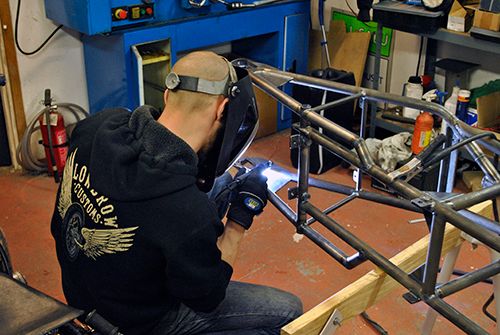 I´ve also finished the winter mods on the daily driver, my Triumph Bonneville -67 that I´ve modified a tad.   I weighed the frame to see how heavy it has become, 16.5kg with the triple tree still in place in the steering head. Not bad. The scale is a bit funny since it begins at 80kg, that is why it looks like it weighs almost 100kg... 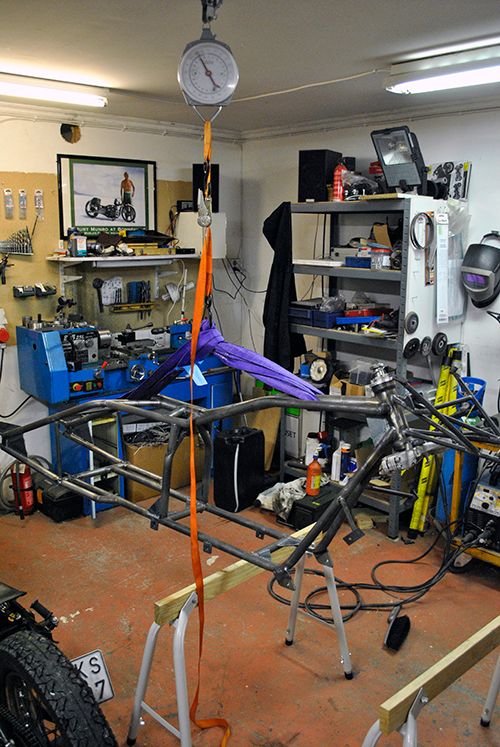 Cheers! /Anders |
|
gidge348
Senior Member
  
Joined: September 2010
Posts: 426 
|
Post by gidge348 on Mar 30, 2014 20:24:05 GMT -5
Nice job Anders, the 67 Bonney looks great. This year at Lake Gairdner I was helping out a friend of mine with his 66 Bonneville (slightly modified)  |
|
|
|
Post by Johansson on Mar 30, 2014 22:55:06 GMT -5
Sweet! How did it run? What´s done with the engine?
|
|
gidge348
Senior Member
  
Joined: September 2010
Posts: 426 
|
Post by gidge348 on Mar 31, 2014 4:08:05 GMT -5
Hi Anders, it ran ok.... sort of, had some problems with the carbs flooding out. A little bit of a hill billy start....  www.youtube.com/watch?v=uXtrRs5Ombw www.youtube.com/watch?v=uXtrRs5OmbwThe engine has reversed barrels, among just about everything else. Salt was not great this year, but ran 2 records, 126mph streamlined and 133mph naked .... has run over 160mph in the past with smaller engine. Cheers Ian.... |
|
|
|
Post by Johansson on Apr 1, 2014 15:34:51 GMT -5
I wish I lived closer to the salt so I could get a bit of seat time on an ordinary bike before I take this one out there, lucky you!   Got some photos taken today so I can see how I need to make the rear fairings, I´ll make a fairing plug out of styrofoam next.  Cheers! /Anders |
|
|
|
Post by racket on Apr 1, 2014 16:23:05 GMT -5
Hi Anders
Nice and compact riding position , keep that frontal area down, minimise the rear "suction" , and you'll be going quick :-)
Cheers
John
|
|